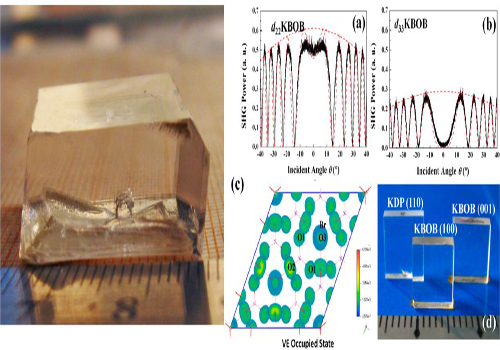
A Sizable Single Crystal K3B6O10Br Synthesized
May 30, 2014 Email"> PrintText Size

Nonlinear optical (NLO) crystals, which are key materials for solid state lasers to produce coherent light through cascaded frequency conversion, have attracted considerable attention. In particular, borate-based NLO crystals have long been a focus because of their moderate NLO coefficients and birefringence combined with wide transparency range and high laser damage threshold, such as β-BaB2O4(BBO), LiB3O5(LBO), CsB3O5(CBO), CsLiB6O10 (CLBO), etc. Recently, introduction of halogen into borate attracted many researchers’ interest, which led to the achievement of aseries of prominent borate halide optical materials.
Prof. PAN Shilie’s group from Xinjiang Technical Institute of Physics & Chemistry, Chinese Academy of Sciences (XTIPC), investigated KBOB and obtained a transparent KBOB single crystal with sizes up to 22 mm × 22 mm × 10 mm by the TSSG method with PbO−KF flux system. A complete survey of linear and nonlinear optical properties, both in experiments and theory, was demonstrated. The birefringence of KBOB is approximately 0.046−0.050 in visible, and the correlations between crystallographic and crystallophysical axes are Z//c, Y//a. KBOB could achieve SHG and THG by direct frequency doubling for the Nd:YAG laser and also can realize FHG by sum frequency with type I configuration. The experimental NLO coefficients of KBOB are d22 = 0.83 pm/V and d33 = 0.51 pm/V, and the corresponding coherent lengths are l22 = 22.2 μm and l33 = 19.0μm. The plane-wave pseudopotential approach is suitable to calculate and predict the linear and nonlinear optical properties for the borate series NLO crystals.
Based on analysis of the SHG-density method, it shows the three-coordinated B2O3 dominates the contribution for producing moderate microscopic second-order susceptibilities; the four-coordinated B1O4 and BrK6 groups also make a small contribution. The results show that KBOB may have significant potential applications in the fields of NLO devices, such as frequency conversion and optical parametric oscillators.
The results have been published on J. Phys. Chem. C. This work was supported by the Western Light Foundation of CAS, 973 Program of China, the National Natural Science Foundation of China and Main Direction Program of Knowledge Innovation of CAS, etc.

Single crystal photo and NLO coefficients analysis of KBOB (Image by XTIPC)
Nonlinear optical (NLO) crystals, which are key materials for solid state lasers to produce coherent light through cascaded frequency conversion, have attracted considerable attention. In particular, borate-based NLO crystals have long been a focus because of their moderate NLO coefficients and birefringence combined with wide transparency range and high laser damage threshold, such as β-BaB2O4(BBO), LiB3O5(LBO), CsB3O5(CBO), CsLiB6O10 (CLBO), etc. Recently, introduction of halogen into borate attracted many researchers’ interest, which led to the achievement of aseries of prominent borate halide optical materials.
Prof. PAN Shilie’s group from Xinjiang Technical Institute of Physics & Chemistry, Chinese Academy of Sciences (XTIPC), investigated KBOB and obtained a transparent KBOB single crystal with sizes up to 22 mm × 22 mm × 10 mm by the TSSG method with PbO−KF flux system. A complete survey of linear and nonlinear optical properties, both in experiments and theory, was demonstrated. The birefringence of KBOB is approximately 0.046−0.050 in visible, and the correlations between crystallographic and crystallophysical axes are Z//c, Y//a. KBOB could achieve SHG and THG by direct frequency doubling for the Nd:YAG laser and also can realize FHG by sum frequency with type I configuration. The experimental NLO coefficients of KBOB are d22 = 0.83 pm/V and d33 = 0.51 pm/V, and the corresponding coherent lengths are l22 = 22.2 μm and l33 = 19.0μm. The plane-wave pseudopotential approach is suitable to calculate and predict the linear and nonlinear optical properties for the borate series NLO crystals.
Based on analysis of the SHG-density method, it shows the three-coordinated B2O3 dominates the contribution for producing moderate microscopic second-order susceptibilities; the four-coordinated B1O4 and BrK6 groups also make a small contribution. The results show that KBOB may have significant potential applications in the fields of NLO devices, such as frequency conversion and optical parametric oscillators.
The results have been published on J. Phys. Chem. C. This work was supported by the Western Light Foundation of CAS, 973 Program of China, the National Natural Science Foundation of China and Main Direction Program of Knowledge Innovation of CAS, etc.

Single crystal photo and NLO coefficients analysis of KBOB (Image by XTIPC)
CAS Institutes
There are 124 Institutions directly under the CAS by the end of 2012, with 104 research institutes, five universities & supporting organizations, 12 management organizations that consist of the headquarters and branches, and three other units. Moreover, there are 25 legal entities affiliated and 22 CAS invested holding enterprisesThere are 124 I...>> more
Contact Us

Chinese Academy of Sciences
Add: 52 Sanlihe Rd., Xicheng District, Beijing, China
Postcode: 100864
Tel: 86-10-68597592 (day) 86-10-68597289 (night)
Fax: 86-10-68511095 (day) 86-10-68512458 (night)
E-mail: cas_en@cas.cn

